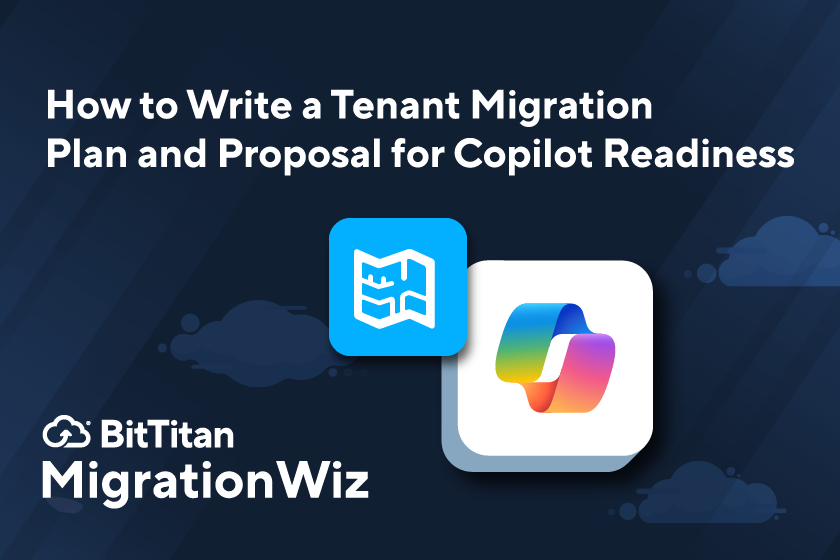Build a Win-Win Migration Proposal for Copilot Readiness
Microsoft Copilot has taken off, and organizations of all types and sizes are flight testing secure generative AI in order to land more aerodynamic services and sky-high productivity. But first they need help preparing the airfield – so to speak.
No need to torture this metaphor any further. Put plane-ly, Microsoft Copilot is changing the way companies organize their data so they can maximize the benefits of enterprise AI. This means opportunities for tenant consolidation projects that lay the groundwork for Copilot readiness.
Migration projects for customers that are preparing to implement Copilot will focus heavily on data. By developing a detailed plan in close collaboration with your customer, you can set them up for success while assuring that data will be protected and used properly. The outline that follows will help you write a proposal for a Copilot readiness migration project. Laying out the project in clear terms will also make pricing easier and more transparent.
Your Project Outline
Lay out your project plan in phases: Pre-migration, migration, and post-migration. Most customers need help structuring their data for AI use, and this is something that needs to be in the plan from the start.
Pre-migration:
1. Understand the customer’s environment and data
This phase will most likely include a consulting fee for assessment and planning. Also be sure to build it into your project timeline. The more specific you are in your proposal, the more the customer will be able to follow along with what’s needed in this discovery phase. Document these data and systems:
- Total user count
- User count by department or business unit
- Quantity of data in each source container, including Mailboxes, SharePoint, and Teams
- Folder count, hierarchy complexity, and overall item counts
- Number of document versions the customer wants migrated and the permissions associated with them
Include a note in your proposal that the results of this phase may alter the projected timeline, which will be adjusted as a clearer picture of the migration’s complexity emerges.
2. Structure user permissions and security
The power of Copilot is its ability to access all the data available to users for generative AI purposes. That’s why data access must be carefully planned before Copilot is implemented to eliminate the chance that users stumble across documents or information they shouldn’t have access to. You can begin this phase by reviewing the organization’s current permissions policy, then use your expertise to design a structure that will maximize data protection.
3. Map the source and destination
For many organizations, Microsoft Copilot will be most impactful when all data is consolidated into a single tenant. However, this plan may vary depending on the needs of your customer. In this phase you’ll discuss their initial plans for using Copilot and how that aligns with the structure of the environment.
Using the information you’ve gathered in the first phase, align source data with containers in each destination. If both the source and the destination are Microsoft cloud tenants, this should be a pretty straight forward one-to-one move. If your customer has any on-premises Exchange or SharePoint servers, you’ll have to factor the move from on-prem to Microsoft 365.
4. Clean and organize the data
Throughout your planning process, be sure to remind customers that Copilot is designed to access all data within the organization that’s available to the user. This is an excellent time to archive or delete data that won’t benefit the organization in this endeavor. Include a phase in which you work with your customer to:
- Delete data that doesn’t conform to the organization’s data retention policy
- Securely delete out-of-date or non-compliant customer data
- Identify large files and huge mailboxes that can be minimized before they cause migration issues
- Have a plan to resolve potential address conflicts
The migration:
After careful preparation that keeps in mind the realities of a Microsoft Copilot environment, your next phase is the migration itself. If you’re experienced with MigrationWiz, you can use your expertise to outline the following phases in your proposal. If you’d like assistance with this or any phase of project planning, be sure to contact the BitTitan customer success team.
- Plan the migration strategy – The size and complexity of your customer’s organization will guide your advice as to whether a big-bang cut-over or a phased approach is the best migration strategy.
- Develop a communication plan – Be sure to involve all appropriate stakeholders and expect to deliver a flow of messages throughout the project so users know what to expect.
- Implement project sharing – With MigrationWiz, multiple users can manage the project, and you can allow your customer’s IT team to view progress as well. Dividing labor based on your team’s skill level will help you manage your personnel budget during this phase.
- Keep an eye on logs – Identify potential issues before they become a problem for users. Be sure to include time in your proposal to deal with issues.
- Have contingency plans – In your proposal, let your customer know what will happen if the project scope or timing changes.
Remind your customer that no migration is error free. But with your team’s expertise, MigrationWiz, and the support of the BitTitan team, the project should run smoothly.
Post-migration:
A Copilot readiness project won’t end when all data is safely in its intended destination. In fact, Microsoft Copilot opens up a world of opportunities for you to design and deploy new ways of working. Think near-term and longer-term:
- Project cleanup – Near-term, your project plan should include a team that stays engaged to identify and migrate any missed files and follow up with users to make sure they’re happy with the results. The time you build into this phase includes keeping the source tenant available for a while in case remediation is necessary.
- Permissions audit – After the dust is settled, and before implementing Copilot, conduct a permissions audit to make sure users have the access they need, but no more than what they should have.
- Copilot training – Your customer will want to maximize the benefits of Copilot. This is an excellent opportunity to provide training that gets users up to speed quickly. You can develop a variety of modules based on user type and customize them for your customer.
- Copilot solutions development – As you move more customers to Microsoft Copilot, you’ll see opportunities to design work processes and customize service offerings. While it might be premature to build this into a migration proposal, make sure your customer knows about the expertise you can provide.
It’s time to take flight! This project outline will help you plan and price your Copilot readiness project. MigrationWiz will help you streamline the migration itself so you can build profitability into that phase. But these projects will be complex, and the best way to assure customer happiness is to carefully detail the entire project so they know what to expect.
Be sure to contact us if you need help with any type of migration project.


